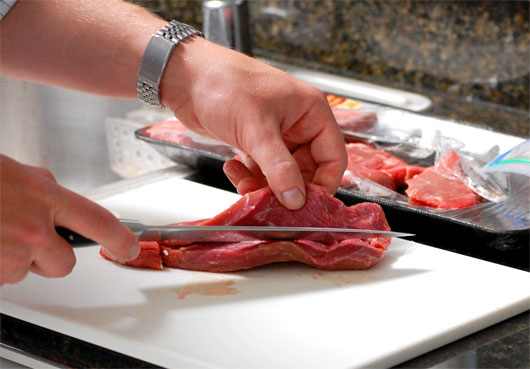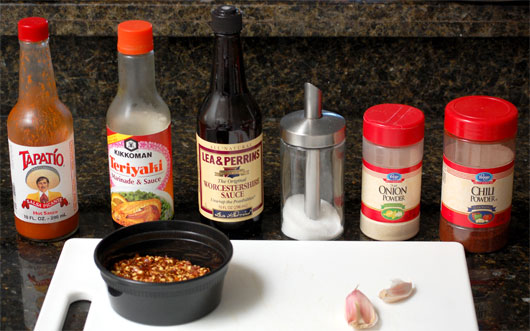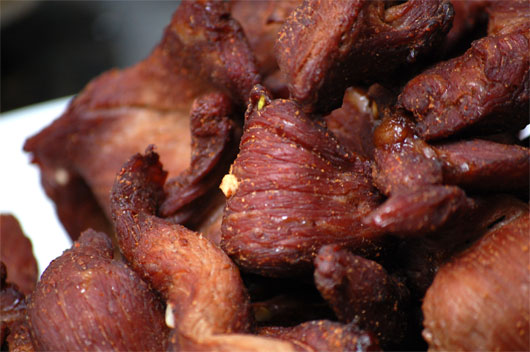Growing up in Central Pennsylvania, I'm no stranger to homemade jerky. I found myself befriending the girls who brought in their father's homemade venison jerky come deer season.
Jerky is one of the healthier foods you can snack on if you get a brand not loaded with preservatives and salt. It's a great way to refuel between meals with its relatively low caloric count and high protein content per serving. So much so, even astronauts request beef jerky because of its low weight and high nutritional value.
And considering what we know about carbs, the importance of protein and the ‘undemonization' of fats, it all adds up to jerky being a hell of a food.
As much as I love jerky, it can quickly become expensive with a 3 oz bag easily costing $5 to $6 and the thought of making my own was tainted with tales of hours of prep and the aid of a high-priced dehydrator.
So imagine my delight and skepticism when I ran across a small blurb in Men's Health claiming jerky could be made at home simply and with no expensive tools.
On one hand excited and the other doubtful I set out to try to make my own beef jerky.
What you'll need:
- Strip steak
- Ingredients for your marinade
- A large resealable plastic bag
- A sharp kitchen knife
How to Make Homemade Beef Jerky
Start out by placing some strip steaks in the freezer for a few minutes. As Men's Health recommends, this firms up the meat and makes it easier to slice.
Remove the steaks from the freezer and cut them first lengthwise then again crosswise. For this step it's really important to have a quality, sharp kitchen knife. I use and really recommend the JA Henkels 4 Star Line. It's affordable and will last you forever. (Check out our review here.)
To get the best results, you want the thinnest slices you can get. Cut the pieces again lengthwise into strips.
The Marinade
The marinade and seasonings give the meat the jerky taste you're after. The Men's Health recipe calls for things like dark-brown sugar, oyster sauce, coriander, and a few other things I don't normally keep on hand. Since I'm not interested in spending a bunch of money to make jerky, when it's already expensive to buy, I chose to use all the good stuff I could find in the pantry already. You're likely to have many of the things I used.
In a bowl mix together your seasonings like:
- Worcestershire sauce
- Teriyaki sauce
- Tapatio
- Fresh garlic
- Sugar
- Onion Powder
- Chili powder
You could substitute things like mustard, BBQ sauce, garlic powder, red wine vinegar, cilantro leaves, curry powder, lime juice, etc.
Place the beef strips and marinade in a large zip top bag and stash it in the fridge for 4-24 hours. I only did 4 and it still had a lot of flavor.
Cook the Jerky
To replace the use of a dehydrator we'll use an oven at a low temperature, which doesn't sound too crazy if you realize all we're trying to do is overcook (without burning) the beef until it's dry.
Place the beef strips right on an oven rack and put a baking pan underneath to catch dripping marinade. A few pieces will inevitably fall off the rack as they shrink, so it's good to have something there to catch them.
Bake at 200°F until dry. Men's Health recommended 45 minutes, I found it took about 90 minutes to really get a nice dry texture.
The Result
It tastes like….beef jerky! I was pleasantly surprised with the outcome, it actually tastes like real beef jerky. The texture is right and the flavor is excellent. I assumed store bought jerky had its taste based on special curing methods and family-secret marinade recipes. Turns out, dry, seasoned beef isn't too hard to make taste good.
The only issue is storage. It probably should be refrigerated after you make it, but when I did that, it made the jerky soggy. I was able to salvage by putting it in the oven again for 20 minutes, but that doesn't seem practical. You'll probably go through it fast enough that you won't find out whether it needs to be refrigerated or not. I almost ate my whole batch in one sitting.
I encourage you to give it a try! In the summer time there will be some great sales on steak at your grocery store, that's a good time to jump in and experiment yourself.
Do you have any experience with making jerky? Share your knowledge with the rest of us in the comments.




















